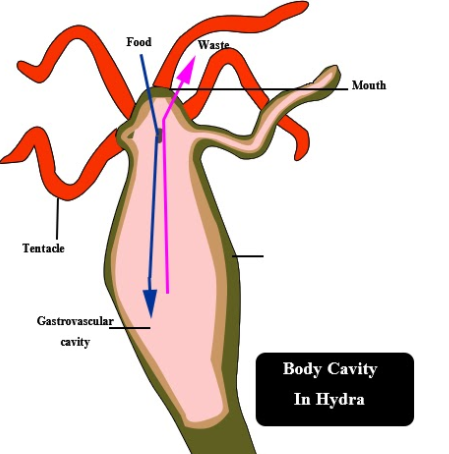
Body cavity of Hydra is called as
a) Enterocoel
b) Coelenteron
c) Gastrovascular cavity
d) Both B and C
Answer
577.2k+ views
Hint: An organ for digestion, circulation, and gaseous exchange along with excretion is located centrally in an organism.
Complete answer:
Hydra belongs from a genus of small, freshwater organisms having a sac-like body with a central body cavity. The body cavity of a Hydra is called a Gastrovascular cavity. It is also known as coelenteron. This cavity may extend into a system of canals.
Additional information:
-Hydra is commonly known as a blind gut or blind sac as the food enters and wastes excreted through the same passage.
-The body of Hydra is radially symmetrical with an adhesive foot called the basal disc.
-At the opening of the mouth few tentacles are present which secrete chemicals to capture the prey.
-Hydra is diploblastic, with two body layers: the epidermis (outer layer), and gastrodermis (inner layer).
-The gastrodermis lines the stomach region.
-The extracellular digestion occurs inside the central cavity of the sac-like body.
-The process of respiration and excretion occurs by diffusion through the epidermal surface.
-The larger waste products are excreted out through the mouth.
So, the correct answer is ‘Both B and C'.

Note:Hydra belongs to the Phylum Cnidaria and class Hydrozoa. They have a unique characteristic feature which attracts the biologists is their regenerative ability. They do not age or die at all. They are composed of various stem cells inside the body column to renew themselves. If Hydra is cut into several pieces then each piece will form a new complete Hydra. This ability of growth and development of hydra is called regeneration.
Complete answer:
Hydra belongs from a genus of small, freshwater organisms having a sac-like body with a central body cavity. The body cavity of a Hydra is called a Gastrovascular cavity. It is also known as coelenteron. This cavity may extend into a system of canals.
Additional information:
-Hydra is commonly known as a blind gut or blind sac as the food enters and wastes excreted through the same passage.
-The body of Hydra is radially symmetrical with an adhesive foot called the basal disc.
-At the opening of the mouth few tentacles are present which secrete chemicals to capture the prey.
-Hydra is diploblastic, with two body layers: the epidermis (outer layer), and gastrodermis (inner layer).
-The gastrodermis lines the stomach region.
-The extracellular digestion occurs inside the central cavity of the sac-like body.
-The process of respiration and excretion occurs by diffusion through the epidermal surface.
-The larger waste products are excreted out through the mouth.
So, the correct answer is ‘Both B and C'.

Note:Hydra belongs to the Phylum Cnidaria and class Hydrozoa. They have a unique characteristic feature which attracts the biologists is their regenerative ability. They do not age or die at all. They are composed of various stem cells inside the body column to renew themselves. If Hydra is cut into several pieces then each piece will form a new complete Hydra. This ability of growth and development of hydra is called regeneration.
Recently Updated Pages
Master Class 12 Business Studies: Engaging Questions & Answers for Success

Master Class 12 Economics: Engaging Questions & Answers for Success

Master Class 12 English: Engaging Questions & Answers for Success

Master Class 12 Maths: Engaging Questions & Answers for Success

Master Class 12 Social Science: Engaging Questions & Answers for Success

Master Class 12 Chemistry: Engaging Questions & Answers for Success

Trending doubts
What is meant by exothermic and endothermic reactions class 11 chemistry CBSE

Which animal has three hearts class 11 biology CBSE

10 examples of friction in our daily life

One Metric ton is equal to kg A 10000 B 1000 C 100 class 11 physics CBSE

1 Quintal is equal to a 110 kg b 10 kg c 100kg d 1000 class 11 physics CBSE

Difference Between Prokaryotic Cells and Eukaryotic Cells




